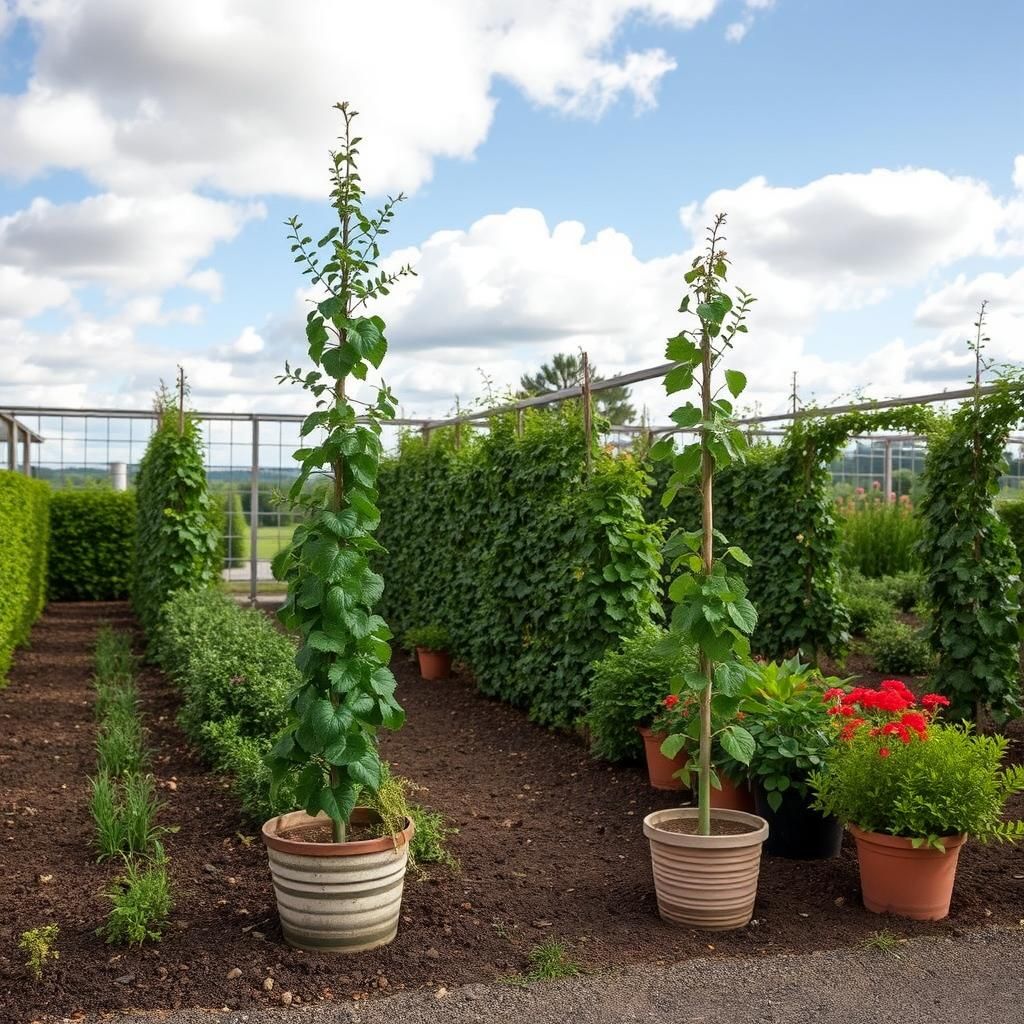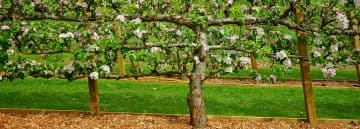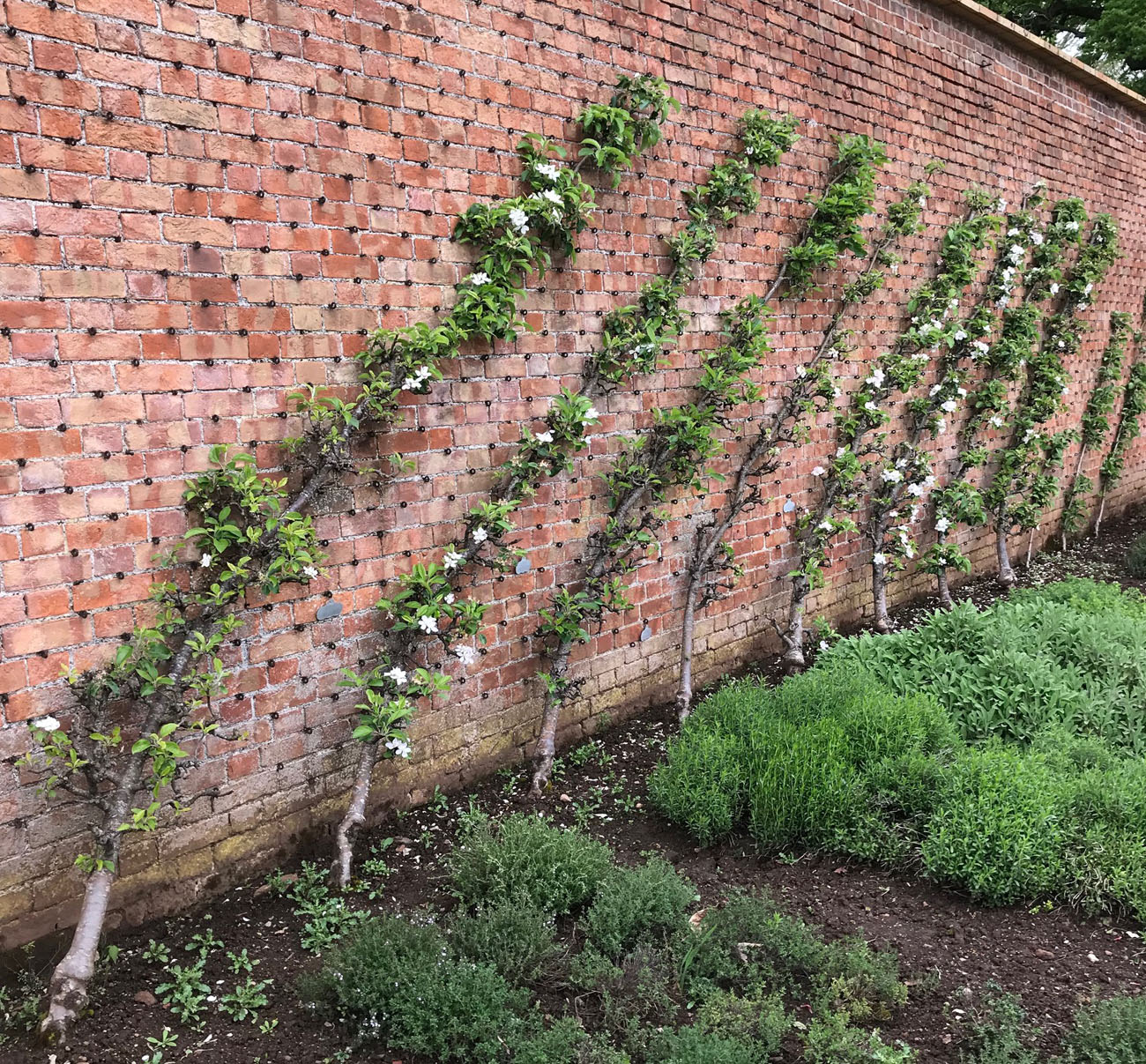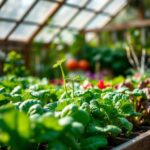Is Cordon the Same as Espalier? A Comprehensive Comparison for Gardeners

In the world of gardening, techniques for training trees and shrubs are essential for maximizing space and promoting healthy growth. Two popular methods that often spark confusion are cordon and espalier. While both aim to create aesthetically pleasing forms and optimize fruit production, they differ significantly in structure, maintenance, and purpose. This article provides a comprehensive comparison of cordon and espalier, exploring their definitions, benefits, and ideal applications for gardeners. Whether you're a novice looking to enhance your garden or an experienced horticulturist seeking new strategies, understanding these techniques will help you make informed choices for your landscape.
Is Cordon the Same as Espalier?
Cordon and espalier are two different training systems used in horticulture to manage the growth of fruit-bearing plants, but they are not the same. The cordon method involves training a plant to grow along a single horizontal or vertical wire or branch, typically with a minimal number of stems, which helps to maximize light exposure and air circulation. In contrast, espalier is a technique that involves training a plant to grow flat against a support, often creating intricate designs along a wall or fence. While both methods aim to optimize growth and production, they each have unique characteristics and applications that cater to different types of plants and growing environments.
Definition of Cordon
Cordon is defined as a growing technique where a plant, often a vine, is trained along a single horizontal or vertical support. This technique encourages monoculture growth, which allows for easier maintenance and better light penetration. The cordon system typically results in a more streamlined plant structure, enhancing both fruit quality and yield.
Definition of Espalier
Espalier refers to the practice of training a tree or shrub to grow flat against a wall or trellis, in a two-dimensional format. This method not only serves aesthetic purposes but also maximizes sunlight access and space efficiency. The design can range from simple, linear forms to complicated shapes, making it a versatile choice for home gardeners.
Purpose of Cordon and Espalier
The purpose of using the cordon system is to simplify the maintenance of plants by concentrating growth and ensuring that each plant receives adequate sunlight and air circulation. On the other hand, espalier serves both functional and aesthetic goals, allowing gardeners to create beautiful patterns while ensuring that the plants remain manageable in terms of space.
Key Differences
The main differences between cordon and espalier lie in their structure and application. Cordon focuses on growing a single stem along a support, while espalier involves multiple branches being trained to grow flat. Additionally, while cordon is predominantly used for specific vine crops, espalier can be utilized with a variety of fruit trees and ornamental plants.
Common Plants for Each Method
Common plants for the cordon method include grapevines and certain types of apple trees, which thrive under this vertical training system. In contrast, espalier can be applied to a wider range of plants, including pears, cherries, and even flowering plants, making it a suitable choice for both edible and ornamental gardening.
| Aspect | Cordon | Espalier |
|---|---|---|
| Structure | Single stem | Flat against support |
| Main Purpose | Maximize light and yield | Aesthetic and manageable |
| Common Plants | Grapevines, apple trees | Pears, cherries, flowering plants |
| Complexity | Simple | Can be complex |
| Maintaining Growth | More streamlined | Requires more training |
What is the difference between a cordon and an espalier?

The difference between a cordon and an espalier lies primarily in their structure and training methods in the horticultural practice of fruit and ornamental tree cultivation. Both techniques allow for space-efficient growth and can enhance fruit production while making harvesting easier. However, they have distinct characteristics and applications.
Cordon Training Explained
Cordon training involves the cultivation of plants along a single horizontal stem, typically with minimal branching. This method is particularly popular among fruit growers, as it can maximize sunlight exposure and air circulation, leading to improved fruit quality.
- Single Stem Orientation: The primary characteristic of a cordon is its focus on a single, usually horizontal stem.
- Minimal Branching: Cordon trees tend to have very few side branches, which are often pruned to encourage a tight growth structure.
- Space Efficiency: This method is ideal for small gardens or urban environments as it requires less horizontal space.
Espalier Style Overview
Espalier is a technique that involves training plants to grow flat against a support structure, such as a wall or trellis. This method not only maximizes space but also creates an aesthetically pleasing visual element in the landscape.
- Flat Growth Habit: Espalier encourages plants to grow in two dimensions, making them flat against a wall or trellis.
- Support Structures: It often requires additional supports, like wires or trellises, to guide the growth direction of branches.
- Aesthetic Appeal: The geometric patterns formed by espaliered plants can enhance garden design and decor.
Fruit Production Differences
While both methods are used for growing fruit-bearing trees, their impact on fruit production can vary significantly.
- Light Exposure: Cordon-trained trees may better optimize sunlight exposure for fruiting, as the branches are often more open.
- Air Circulation: Improved air circulation can lead to healthier fruit, reducing fungal diseases.
- Harvesting Ease: Both methods facilitate easier harvesting, but cordons often allow for better access due to their simplified structure.
Maintenance Requirements
The maintenance techniques for a cordon and an espalier differ not only in pruning but also in overall care practices.
See also:
- Pruning Techniques: Cordon pruning generally requires fewer cuts each season compared to the more intricate pruning needed for espalier.
- Watering Needs: Both methods have similar watering needs, but espalier may require more frequent irrigation due to the increased foliage.
- Pest and Disease Management: The open structure of both methods can help with pest management, yet cordons might be less prone to certain diseases due to better airflow.
Visual and Design Aspects
The visual appeal of cordons and espaliers can greatly enhance garden aesthetics, but they each bring unique looks to the landscape.
- Design Versatility: Espaliers offer greater versatility in terms of design patterns, allowing for artistic shapes and forms.
- Height Control: Cordon trees can be maintained at lower heights, making them suitable for lower garden areas or social spaces.
- Seasonal Interest: Both options can provide visual interest throughout the seasons, but espaliers often showcase more lush foliage against the backdrop of walls or structures.
What is another name for an espalier tree?
The term espalier tree is often associated with the technique of training fruit trees or other plants to grow flat against a structure or wall. Another common name for an espalier tree is a trained tree or formative tree. These names highlight the method used to cultivate the tree, emphasizing its artificial shape and structured growth.
What is an Espalier Tree?
An espalier tree refers to the process of growing trees in a specific pattern against a wall or trellis, allowing for easier management and increased sunlight exposure. This technique can be applied to various types of fruit trees or ornamental plants. The benefits of this method include:
- Maximized space in gardens.
- Improved air circulation around the plant.
- Enhanced aesthetic appeal through unique shapes.
History of Espalier Trees
The practice of espaliers dates back to ancient civilizations, particularly in Egypt and China, where gardeners developed structured methods to cultivate trees. Over the centuries, these techniques spread to Europe, particularly in France and Italy, where they became popular in formal gardens. Key points in its history include:
- An increase in fruit production methods during the Renaissance.
- The incorporation of espaliers in royal gardens.
- A modern resurgence in garden design emphasizing space efficiency.
Benefits of Espalier Trees
Espalier trees offer numerous advantages, particularly for gardeners with limited space. The structured growth provides not only an aesthetic quality but also functional benefits. Some of these benefits include:
- Facilitating harvest due to easier access.
- Reducing wind damage by providing a natural barrier.
- Creating microclimates to protect delicate fruits.
Types of Trees Suitable for Espaliering
Not all trees are suitable for espaliering, but several types thrive under this care. Common choices for espalier trees include:
- Apple trees, which respond well to shaping.
- Pear trees, appreciated for their fruit and structure.
- Citrus trees, which can be trained quite successfully.
Techniques for Creating Espalier Trees
Creating an espalier tree involves specific techniques to ensure proper growth. Gardeners usually follow a set of steps:
- Selecting a suitable support structure, like a fence or trellis.
- Deciding on a desired shape, such as fan, candelabra, or lattice.
- Regular pruning and tying branches to encourage the desired growth.
Which word means the same as espalier?

The word that means the same as espalier is fan. An espalier is often designed in a specific pattern, and one of the most common forms is the fan shape. This technique involves training trees or shrubs in a certain format against a wall or fence for both aesthetic purposes and to maximize sunlight exposure for the plants.
What is a Fan in Gardening?
A fan in gardening refers to a style of plant training where the branches of a plant are spread out in a fan shape, typically against a wall or fence. This method allows for better sunlight penetration and air circulation, making it an effective way to grow fruit trees or ornamental plants in limited spaces.
- Enhances access to sunlight.
- Improves aesthetics in garden design.
- Facilitates easier maintenance of plants.
Benefits of Using Espalier Techniques
Employing espalier techniques provides numerous advantages for gardeners. It maximizes space usage in small areas, allows for easier harvest of fruit, and can create beautiful living art forms in the garden. Moreover, the practice can lead to increased fruit production due to optimal sunlight exposure.
- Compact growth in limited spaces.
- Increased yields of fruit crops.
- Higher visual interest in landscape design.
Examples of Plants Suited for Espalier
Many plants are well-suited for espalier techniques. Common choices include various fruit trees, such as apples and pears, as well as ornamental shrubs. These plants can be effectively trained to grow in the desired shape while maintaining healthy growth patterns.
See also:
- Apple trees (Malus domestica).
- Pear trees (Pyrus communis).
- Various ornamental shrubs like jasmine and climbing roses.
Historical Context of Espalier
The practice of espalier has a rich historical context that dates back to ancient civilizations. It was commonly used in Europe during the Renaissance to create formal gardens and maximize the limited sunlight in urban areas. The practice reflects not only practical gardening methods but also a commitment to aesthetics in landscape design.
- Originated in ancient Rome and China.
- Popularized in Renaissance gardens.
- Represents a blend of utility and beauty.
Techniques for Effective Espalier Training
To successfully train plants as espaliers, several techniques should be employed, including selection of the right framework for support, regular pruning, and careful tying of branches to encourage the desired shape. It's important to maintain consistent care to achieve the best results.
- Choose a sturdy support structure.
- Regularly prune to encourage growth in desired directions.
- Use soft ties to secure branches without damaging them.
What is a plant cordon?

A plant cordon is a training method used in horticulture and agriculture to optimize the growth and fruiting of certain plants, particularly fruit trees and some vegetables. The basic principle of this technique is to encourage the plant to grow in a specific direction or form, often vertically, by using a support system. This not only improves the physical appearance of the plants but also enhances air circulation, sun exposure, and ease of harvesting, all of which can lead to an increase in the quality and quantity of the crop produced.
Benefits of Using a Plant Cordon
The plant cordon technique offers several advantages that can significantly impact the growing process and yield of plants. These benefits include:
- Increased sunlight exposure: By training plants vertically, you ensure that foliage receives more direct sunlight, which is essential for photosynthesis.
- Better air circulation: A well-structured cordon allows for enhanced airflow between plants, reducing the risk of diseases caused by stagnant moisture.
- Space-saving: Utilizing vertical space is particularly beneficial in smaller gardens, maximizing yield without requiring additional ground area.
How to Create a Plant Cordon
Establishing a plant cordon involves several steps that require careful planning and execution. Generally, the procedure includes:
- Selecting the right plant: Certain plants, such as apple and pear trees, respond particularly well to this training method.
- Choosing a support system: Options include trellises, stakes, or wires that can adequately support the growth of the plant.
- Regular pruning: Maintain the shape and health of the plant by regularly pruning any unwanted shoots that detract from the desired form.
Types of Plant Cordons
There are various types of cordon forms, and the choice often depends on the specific plants being cultivated and the grower's preferences. Some common types include:
- Single cordon: This is a straightforward approach where a single stem is trained vertically with minimal branches.
- Double cordon: In this method, two trunk-like stems stretch along the support system, allowing for increased production.
- Oblique cordon: This interesting style involves training the plant at an angle, maximizing light capture and yielding a unique aesthetic.
Plants Suitable for Cordon Training
Several plants are well-suited for the cordon method, each benefiting from the structured support. Notable examples include:
- Fruit trees: Particularly apples and pears, which yield high-quality fruit when trained properly.
- Vine crops: Plants like grapes and kiwis thrive when given a framework to climb.
- Vegetables: Certain types, such as tomatoes and peppers, can benefit from cordon techniques to improve overall plant health and yield.
Common Mistakes to Avoid with Plant Cordons
When employing the cordon method, it's important to avoid certain pitfalls to ensure successful growth. Common mistakes include:
- Neglecting pruning: Failing to prune regularly can lead to overcrowding and decreased fruit quality.
- Insufficient support: Using weak or inadequate supports might not sustain the weight of the plant as it grows.
- Overwatering: Be careful not to overwater, as poorly draining soil can lead to root problems.
Questions from Our Readers
Is cordon the same as espalier?
No, cordon and espalier are not the same. A cordon is a specific type of training method where a plant is grown along a single horizontal stem, while espalier involves training a plant to grow flat against a support, often creating a more intricate pattern.
What are the main differences between cordon and espalier?
The main differences lie in their structure and design; the cordon system typically emphasizes a linear growth along a stem, whereas espalier allows for more elaborate shapes and multiple branches, offering more decorative and space-saving options in gardens.
Can any plant be trained as a cordon or espalier?
Not every plant is suitable for both methods; cordon training is often used for fruit-bearing plants like grapes, while espalier can be used with various trees and shrubs, making the choice dependent on the plant's natural growth habits.
What are the benefits of using cordon or espalier methods?
Both methods provide benefits such as saving space, enhancing sunlight exposure, and improving air circulation, which can lead to healthier plants and better fruit production. Additionally, they can serve as an attractive landscape feature in gardens.
See also:

If you want to read more articles like Is Cordon the Same as Espalier? A Comprehensive Comparison for Gardeners, we recommend you check out our Gardeners category.
Leave a Reply

Related Articles